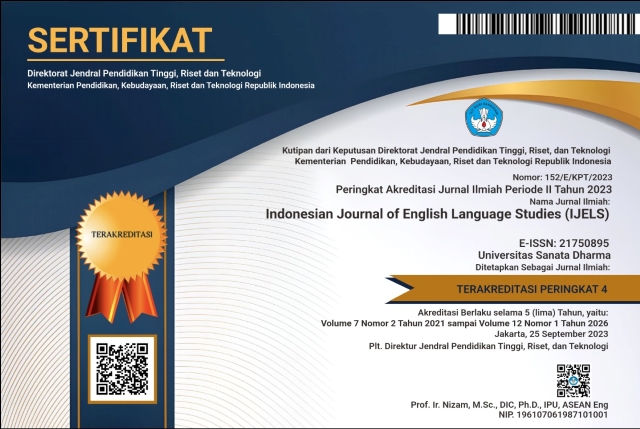The Circulation, Translation, Adaptation, and Production of Vedya’s the Mahabharata and Pramoedya’s Selected Writings
(1) Sanata Dharma University
(*) Corresponding Author
Abstract
The paper aims to show how non-Western literature works are integrated into World English Literature. It highlights two non-Western literature works, one from India and the other from Indonesia. The object of this study is Mahabharata and Pramoedya’s selected writings. The analysis focuses on comparing them from the process of circulation, translation, adaptation and production to depict the values and portrayal of women in different time spans. The result of the analysis is that the values in Mahabharata are still relevant until today, therefore people may learn from its philosophical life meaning about brotherhood and loyalty. Meanwhile, Pramoedya’s selected writings show the value of nationalism, loyalty, and humanity. The similarities of both literary works also lie in portraying the issue of feminism in responding towards the life challenges.
Keywords
Full Text:
PDFReferences
Bassnet, S. (1993). Comparative Literature: A critical introduction. London: Blackwell Print.
Beck, A. (2012). A stage of one’s own: The artistic devolution of contemporary Scottish theatre. International journal of Scottish theatre and screen, 5(1), 48-54. Retrieved on 21 October 2016.
Damrosch, D. (2008). Toward a history of world literature. New literary history, 39(3), 481-495. Retrieved on 21October 2016.
. (2009). How to read world literature. London: Wiley Clackwell Publishing.
Das, S. (2014). Vyasa’s Draupadi: A feminist representation. International journal of gender and women’s studies, 2(2), 223-231. Retrieved on 21October 2016.
Dewi, N. (2013). Women of will for nation building in Pramoedya’s three early novels. Kritika kultura, 20(-), 27. Retrieved on 21 October 2016.
Henitiuk, V. (2012). The single, shared text? Translation and world literature. World literature today, 86(1), 30-34. Retrieved on 21 October
Kalb, J. (2010). The Mahabharata: Twenty-five years later. A journal of performance and art, 32(3), 63-71. Retrieved on 21 October 2016.
Lane, M. (2016). Why you should read ‘This Earth of Mankind”. ASIAN STUDIES: Journal of critical perspectives on Asia, 52(1), 104-116.
Retrieved on 21 October 2016.
Maitra, T., & Saha, N. (2016). Women in "The Mahabharata": Pawns or players. Research Journal of English Language and Literature (RJELAL), 4(3), 83-93. Retrieved on 21 October 2016.
Puspita, I. (2015). Voicing change: A comparative reading of selected works by Pramoedya Ananta Toer and Katharina Susannah Prichard. Ahmad Dahlan Journal of English Studies (ADJES), 2(2), 38-48. Retrieved on 21 October 2016.
Ramli, A. J., & Aziz, S. A. (2014). Nyai in patriarchal and colonial society: A subaltern study of Nyai Ontosoroh in Pramoedya Ananta Toer’s Bumi Manusia. Malay Literature, 26(2), 182-204. Retrieved on 17 November
Shields, K. (2013). Challenges and possibilities for world literature, global literature, and translation.” Comparative literature and culture, 15(7), 2-9. Retrieved on 14 October 2016.
Siskind, M. (2010). The globalization of the novel and the novelization of the global: A critique of world literature. Comparative literature, 62(4), 336-360. Retrieved on 21 October 2016.
Susanti, Y. (2014). The role of imprisonment and censorship in the international success of Pramoedya Ananta Toer’s Buru Quartet Novels. Jurnal LINGUA CULTURA, 8(2), 95-100. Retrieved on 21 October 2016.
Thapar, R. (2009). War in the Mahabharata. PMLA, 124(5), 1830-1833. Retrieved on 21 October 2016.
Truschke, A. (2011). The Mughal book of war: A Persian translation of the Sanskrit Mahabharata. Comparative studies of South Asia, Africa and the Middle East, 31(2), 506-520. Retrieved on 21 October 2016.
Wahyudi, A. (2013). Transformasi Yudhisthira Mahabarata dalam tradisi pedalangan. Resital, 14(1), 71-80. Retrieved on 21 October 2016.
Kurniawan, E. “Clarice Lispector, El Boom, Penerjemahan.” Retrieved on
October 2016 from http://ekakurniawan.com/journal/clar ice-lispector-el-boom-penerjemahan- 5507.php
Wahid, I. Drama Nyai Ontosoroh Pentas Ulang di Salihara. Retrieved on 22 April 2017 from https://m.tempo.co/read/news/2011/03/25/113322867/drama-nyai- ontosoroh-pentas-ulang-di-salihara
DOI: https://doi.org/10.24071/ijels.v3i1.573
Refbacks
- There are currently no refbacks.

This work is licensed under a Creative Commons Attribution-ShareAlike 4.0 International License.
IJELS Journal Sinta 4 Certificate (S4 = Level 4)
We would like to inform you that Indonesian Journal of English Language Studies (IJELS) has been nationally accredited Sinta 4 by the Ministry of Education, Culture, Research and Technology of the Republic of Indonesia based on the decree No. Surat Keputusan 152/E/KPT/2023. Validity for 5 years: Vol 7 No 2, 2021 till Vol 12 No 1, 2026

This work is licensed under CC BY-SA.
Creative Commons Attribution-ShareAlike 4.0 International License
IJELS e-ISSN 2715-0895; IJELS p-ISSN 2442-790X
Indonesian Journal of English Language Studies (IJELS) is published twice a year, namely in March and September, by the English Language Studies (ELS) of the Graduate Program of Sanata Dharma University, Yogyakarta, Indonesia.


 IJELS p-ISSN:
IJELS p-ISSN: 









